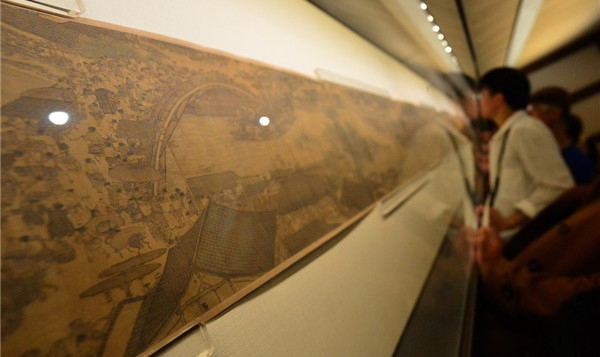Renowned scroll painting reveals hidden meaning

Visitors view the famous scroll painting Along the River During the Qingming Festival in a special exhibition celebrating the museum’s 90th anniversary in the Hall of Martial Valor at Beijing’s Palace Museum.
The best-known scroll painting in Chinese art history—Along the River During the Qingming Festival—was completely unrolled for the first time since 2005 in the Hall of Martial Valor at Beijing’s Palace Museum, also known as the Forbidden City, stirring up another heated discussion on its political and cultural significance.
The scroll is part of a special exhibition titled The Precious Collection of the Stone Moat, which is being held to celebrate the museum’s 90th anniversary.
Continuous popularity
The painting depicts a flourishing landscape in Bianjing, the political, economic, and commercial center of the Northern Song Dynasty (960-1127). Bianjing is today the city of Kaifeng in Henan province.
Cheng Minsheng, director of the Institute of Song Dynasty Studies at Henan University, said: “The craze for studying this painting never fades and keeps growing. For one, emerging derivative products have formed a cultural industry. Also, the painting has become the cultural symbol for an aspiring city in China.”
Apart from simple appreciation of the painting’s artistic charms, Cheng said, people are drawn to the piece out of a desire to return to nature and adopt a colorful but leisurely lifestyle, amid the modern tide of urbanization.
Cheng also said that for historians and scholars of other related disciplines, the artwork provides a vivid image and abundant supporting evidence for written documents regarding the details of the city and people’s daily lives during the Song Dynasty, which explains the continuous popularity of the painting.
Yu Hui, who heads the research department of the Palace Museum, said that the painting covers all facets of life, including commerce, trade, construction, bridges, irrigation, climate and medical care, thus attracting attention from all these areas.
Yu also pointed out that as a depiction of daily life, it is close to and thus easily appreciated by ordinary people.
Hidden political, cultural codes
The scroll is full of details, which contain the artist’s vaguely expressed concerns toward the political and cultural ecology at the time, allowing scholars to decode it from multiple perspectives.
Cao Xingyuan, a professor from Northeast Normal University, said that the painting may have been created during the reign Emperor Shenzong (1067-85) of the Song Dynasty.
“Emperor Huizong (reigned 1100-25) was fond of the elegant and delicate style. However, Along the River During the Qingming Festival is a piece that is more down to the earth and reflects ordinary lives,” Cao said. “There are no historical records of court artists who dared to submit such a critical piece that contains the thoughts of the populace and at the same time does not cater to the emperor’s artistic tastes.”
Cao said there is one core detail that hints at the social crisis at the time: A boat that is about to cross the bridge is likely to hit another boat due to a deviation from its route. People on the boat and the bridge are shown working together to put the boat back on track and avoid the collision.
Yu said there is another key detail on the scroll: A man is counting the coins for shipment and two wagon haulers are struggling to carry them. The coins depicted there were believed to have been forged during the reign of emperor Huizong. One of these coins was equal to 10 copper coins, signaling the beginning of soaring prices in the late Northern Song Dynasty.
Realist but not real
Going forward, Cheng said there should be an understanding that the painting is a realist work of art, rather than a sketched out scene. The painter was more concerned with artistic factors, such as composition and lines, so its historical value was not revealed on purpose. Rather, it was found and approved by later generations.
Therefore, there cannot be anything in the scroll that has not been created in the era, and we certainly cannot prove history through the things that do not appear at all, Cheng noted.
Cao said the fact that some Chinese and Western scholars are trying to locate the city the painting depicts does not make much sense, because it is an artistic work of imagination, so it can merely be a metaphor for reality.
Zhang Chunhai and Sun Miaoning are reporters at the Chinese Social Sciences Today.
